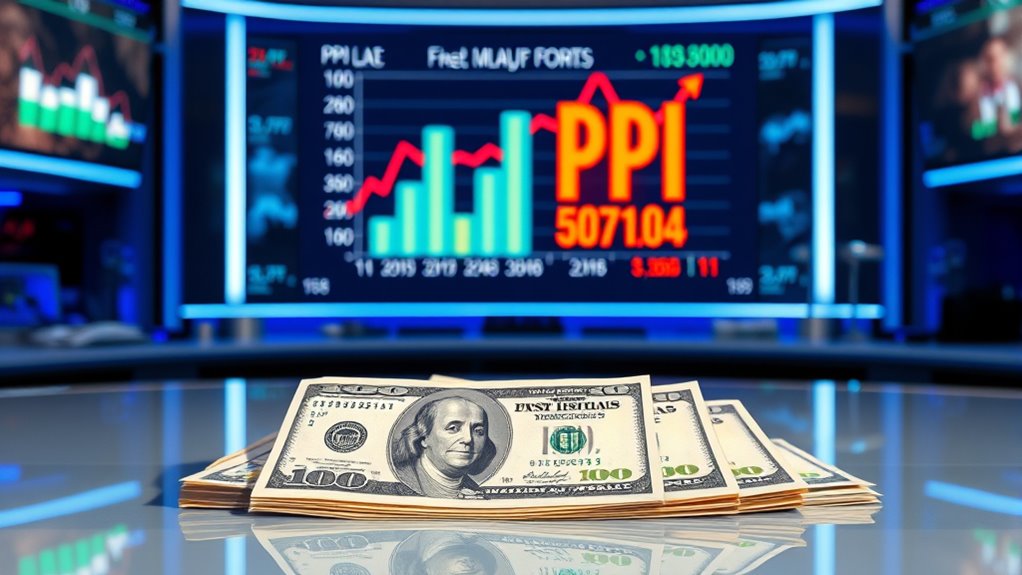You see the dollar rally after the hotter-than-expected PPI numbers because investors anticipate more aggressive Federal Reserve rate hikes to counter rising inflation. The PPI’s sharp increase signals widespread inflation pressures across sectors, prompting markets to reassess the Fed’s plans. As upstream costs keep climbing, the dollar remains strong, reflecting expectations of tighter monetary policy. If you want to understand how this trend could impact the economy and your investments, keep exploring further.
Key Takeaways
- Hotter-than-expected PPI signals increased inflation pressures, boosting confidence in a more aggressive Federal Reserve stance.
- Strong PPI data supports a higher US Dollar due to expectations of sustained interest rate hikes.
- Market reactions include a decline in interest rate futures, reflecting anticipation of tighter monetary policy.
- Rising upstream costs indicate persistent inflation, encouraging demand for the dollar as a safe haven.
- The inflation surprise reinforces USD strength amid expectations of prolonged high interest rates.

Are hotter-than-expected Producer Price Index (PPI) numbers fueling a surge in the US dollar? Recent data shows that the PPI for final demand increased by 3.3% annually in July, surpassing the forecasted 2.5% and marking a significant acceleration from June’s 2.4%. This unexpected jump suggests that upstream costs are rising faster than anticipated, signaling persistent inflation pressures that could influence monetary policy decisions. The core PPI, which excludes volatile food and energy prices, also climbed sharply—up 3.7% year-over-year in July, compared to 2.6% in June. Both overall and core PPI numbers surged by 0.9% on a monthly basis, with the July core figure representing the largest monthly increase in over three years. These figures indicate that inflation is broadening beyond temporary shocks, driven by resilient sectors like transportation and trade margins, which saw services prices rise 1.1% month-over-month. Goods prices also jumped notably, led by a staggering 38.9% spike in vegetable prices, while energy costs contributed to overall upward pressure on goods. The persistent inflation in core goods reflects underlying inflation that isn’t just tied to volatile sectors, signaling that inflationary pressures are becoming embedded across different parts of the economy. This data also points to potential challenges for the Federal Reserve’s upcoming policy meetings. Furthermore, the rising costs of best vegetable pots may contribute to increased consumer prices as businesses adjust to their own operational costs. Market reactions to this data have been swift. The US Dollar Index remained firm above 98.00, reflecting traders’ expectations of tighter monetary policy from the Federal Reserve. As the PPI numbers exceeded forecasts, interest rate futures declined across the curve, indicating market reassessment of the Fed’s rate trajectory. This stronger inflation signal reinforces the likelihood of additional rate hikes, as the Fed aims to keep inflation in check without risking an economic slowdown. Investors see the rising PPI as a leading indicator of consumer price inflation, which influences the Fed’s policy stance. The data suggests that upstream supply chain costs are rising, and while businesses have absorbed some of these increases so far, they’re likely to pass more costs onto consumers gradually. Factors such as clearer tariff policies, rising wage costs, and sustained inflation in services sectors contribute to these upstream pressures. The persistent rise in core PPI underscores that inflation isn’t just a temporary phenomenon but a more ingrained issue that requires ongoing policy attention. The Fed’s next moves will hinge on how PPI trends evolve alongside consumer inflation and employment data. Hotter inflation signals like these complicate the outlook for dovish policies, as they point to the need for continued tightening to prevent inflation from becoming entrenched. The PPI release further cements expectations that interest rates will stay high or even rise, supporting the dollar’s recent strength. Going forward, traders and policymakers will closely monitor upcoming PPI data releases, as they provide critical insights into supply chain dynamics, inflation momentum, and the future path of US monetary policy.
Frequently Asked Questions
How Will the Fed Respond to Rising PPI Figures?
The Fed will likely respond to rising PPI figures by considering tightening monetary policy if inflation pressures persist. You should watch for potential interest rate hikes, especially if PPI gains signal broader, sustained inflation. The Fed will analyze whether these increases are temporary or persistent, relying on a data-driven approach. If inflation continues to rise above target levels, expect the Fed to act to prevent inflation from becoming entrenched.
What Sectors Are Most Impacted by the PPI Increase?
You’ll notice that the services sector, especially insurance, brokerage, and management firms, faces significant pressure from rising costs. Energy and utilities, like electricity and natural gas, are also heavily impacted, driving up wholesale prices. Goods-producing industries, including plastics and oil extraction, see increased input costs. Financial services, such as insurance, are affected too, resulting in higher premiums and risk management expenses. Overall, these sectors experience persistent inflation, influencing broader economic activity.
How Does PPI Data Influence Consumer Inflation Expectations?
When PPI data shows rising producer prices, you naturally start to expect higher consumer prices soon. This signals that costs are increasing upstream, and retailers may pass these costs onto you. As a result, your inflation expectations get adjusted upward, influencing your spending, saving, and wage demands. You might also see changes in market behavior and policymakers’ responses, as everyone anticipates ongoing inflation driven by rising production costs.
Are There Historical Patterns Linking PPI Spikes and USD Movements?
Historical hurdles highlight that PPI spikes often prompt USD pulsations. When producer prices rise rapidly, markets typically react, reinforcing the USD’s strength or sparking swift shifts. You’ll notice that in past periods, surging PPI signals inflationary pressures, prompting investors to favor the dollar for safety. This pattern suggests that persistent PPI peaks tend to promote USD appreciation, especially when aligned with favorable trade and trade-related terms, shaping the currency’s course.
What Are the Long-Term Implications of Sustained PPI Growth?
If PPI keeps rising over the long term, you’ll likely see sustained inflation that erodes consumers’ purchasing power. This can lead to higher wages, increased costs for businesses, and potential wage-price spirals. Investors might shift toward inflation-protected assets, and currencies like the USD could strengthen due to expectations of tighter monetary policy. Ultimately, persistent PPI growth could slow economic growth and cause market volatility as inflation expectations become entrenched.
Conclusion
As the PPI numbers ignite the dollar’s ascent, think of this rally as a lighthouse piercing through economic fog. The hotter figures signal storms ahead, urging you to stay alert and navigate carefully. Just as a lighthouse guides ships safely ashore, these data points steer the market’s course, reminding you that in uncertain waters, clarity and vigilance are your best anchors amidst the rising tide.









